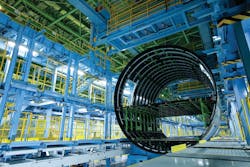The industry is witnessing (albeit from afar) a watershed repair just now, one scrutinized and debated as few in the annals of modern MRO. The subject is an Ethiopian Airlines Boeing 787, the victim of a crown fire in the rear of the craft’s composite fuselage as it sat empty and idle out on the ramp at London Heathrow on July 12, 2013.
The locus of the fire looks to be the 787’s lithium battery-powered Emergency Locator Transmitter. Contrary to first impression, that fire did not burn a hole through the structure. “It only looks like it in the pictures,” says Michael J. Hoke, president and owner of Abaris Training Resources, the Reno-based composites training firm. He says, “It did not burn through the laminate, but it was hot enough to burn the paint off the outside,” rendering “the illusion of a hole.”
Still, the result was significant structure damage. Hoke estimates the affected area on the inside “on the order to 10 feet long.”
Although “not privy to the exact details” of the resultant repair, he offers a possible architecture for the fix. Boeing spokesman Jim Condelles declines comment, saying only “Boeing and Ethiopian Airlines are working in partnership to complete the repair. Work has started in London and is progressing well.” The repair’s particulars probably won’t be disclosed in any real depth until early 2014.
The fix may be an adhesively bonded patch. That’s what The Seattle Times reported an unnamed Boeing engineer as saying.
When word of the extent of the damage first surfaced speculation was Boeing might have to replace a complete composite fuselage barrel. That’s apparently not the tack the OEM took.
Remember, the 787’s fuselage is composed of separate “barrels,” each crafted via fiber placement. The result is integral and one-piece, replete with stiffeners. By contrast, the seven-eight’s arch-competitor, the A350, wraps composite skin pieces around a substructure.
Repairing primary structure
Although Hoke hasn’t physically seen the damaged Ethiopian twinjet, one approach envisions Boeing performing a double-sided scarf repair in which technicians sand layers of laminates at a very flat angle. For illustrative purposes, Hoke uses a simpler example than the 787’s fuselage, a flat piece of composite laminate with a hole punched in it. Before the tapering begins, he says, “The first thing you’d want to do is cut away the damaged material and get a nice, clean oval-shaped, or perhaps circular hole.” That leaves technicians with good material to work with.
Gradated, flat sanding produces repair plies that are larger than the hole. That’s what begets good load transfer, the essential element of any composite structural repair, particularly primary structure. “The idea is to get a long adhesive bond joint through the original structure to the repair plies,” says the Abaris executive.
Just how robust those load-bearing properties are depends on scarf angle and ply count. “They can get back to [the] full strength of the original undamaged structure – or more than full strength – if they use extra plies,” says Hoke. For a 75-ply original skin, you might want to use 85 or 90 plies in the repair. Stronger is better; but not too strong. “There’s no point in going way stronger than the original structure,” he says. Make that mistake and “you create load transitions at the edges of the repair, which can be harmful.” The risk lies in building up a “hard spot” in the composite laminate.
Next comes adhesion. A good adhesive bond means meticulous preparation of the bond line itself, that crucial part of the structure that will shoulder the load. Go back to Composites 101 and you’ll see that dirt, oil, grease, and even fingerprints can contaminate the works.
As for curing the fix, Hoke says a repair of the size of the Ethiopian craft demands either multiple heat blankets, infrared lamps, or perhaps even erecting a “temporary oven” around the structure. Technicians could employ a combination of techniques to effect a cure. He says, “There are lots of ways to do it.”
Enter the robot
With scarfing in particular, skill is the irreducible component. “If you don’t follow [preparation, scarfing, and bonding] processes the way you’re supposed to, the … result will be very much dependent on the mechanic who performed it,” says Christian Sauer, manager engineering, airframe-related components for Lufthansa Technik.
To reduce vexing variability, LHT Rapid Repair injects robotics into what’s traditionally been an artisan equation. Rapid Repair scans the damage, calculating the precise architecture of the fix. Then, the machine does the scarf. Sauer contends bond strength is “10 percent” better than with traditional methods.
LHT has demonstrated Rapid Repair on secondary structures in its shop. The next step is to make the machine mobile, and eventually employ it on primary structure. That’s the aim of Lufthansa Technik’s Composite Adaptable Inspection and Repair (CAIRE) effort.
Quality, of course, remains the ultimate aim – be the process manual or automatic. Assuring that quality is an array of nondestructive inspection techniques: ultrasonics, thermal imaging, and sophisticated shearography. These nondestructive approaches are backstopped by test samples built up alongside the repair itself. They’re built by the same technicians, using the same materials, the same adhesives, and the same cure cycle. Then they’re sent off for destructive testing to assure the bond is strong and true.
Whatever the architecture of the Ethiopian 787 repair in situ, Hoke sees it as consuming “some weeks, but probably only a few.”
The regulatory nexus
What Hoke is willing to bet on is that “they’re going to spend more time on the design and approval process than they will physically doing the repair on the airplane.”
Federal Aviation Administration spokesman Les Dorr declines to address the Ethiopian incident specifically. But he does say, “'FAA-approved’ repair methods depend on available data (repair design, fabrication trials, and proof-of-structure substantiation) to meet the applicable regulations.” Typically, this data includes “suitable loads, internal stresses, design criteria, and requirements for the specific parts” as well as “analysis and tests for structural substantiation.”
As Aircraft Maintenance Technology got set to go to press, one as yet officially unanswered question was whether the Ethiopian repair reverted to tried-and-true doublers. Hoke says in some areas you can exact the “equivalent of an aluminum repair done with doublers.”
Bolted or bonded
He says any “major” repair, such as the 787’s fuselage – be it bolted or bonded – “must be approved on a case-by-case basis” by the applicable regulatory agency, such as FAA or EASA. The Abaris chief says there’s currently a “conservative limitation” on the size of damage to primary composite structure subject to bonded repair. The fix must “continue to operate, at limit load, assuming the repair patch is not there.”
Lufthansa Technik’s Christian Sauer is direct. “At the moment, if you need to transfer loads, the authorities require that [you] bolt the repair. So, you can bond it – but then you have to put a bolt through it. You need a second load path in case the bond fails.”
To bond, to bolt, or both? Neither airframer nor airline were commenting. Whatever the specifics of the fix you can bet everyone is paying attention. This one could rewrite the book.
As of early January the Ethiopian Airlines 787 is back in passenger service. Boeing said the "repair and refurbishment took approximately two months and has returned the airplane to full structural integrity, with no degradation to passenger safety or comfort."
Jerome Greer Chandler is a two-time winner in the Aerospace Journalist of the Year' competition's Best Maintenance Submission category; he won in 2000 and 2008. His best-seller 'Fire and Rain' chronicles the wind shear crash of Delta Flight 191 at DFW. Chandler's passion for aviation safety is more than professional. It's personal. Two of his relatives have perished on commercial airliners, one of them in the infamous Braniff Electra crash of 1959.
About the Author
Jerome Greer Chandler
Jerome Greer Chandler is a two-time winner in the Aerospace Journalist of the Year competition's Best Maintenance Submission category; he won in 2000 and 2008. He received the Lifetime Achievement Award at the 2017 Aerospace Media Awards in Paris, France. His best-seller 'Fire and Rain' chronicles the wind shear crash of Delta Flight 191 at DFW.

